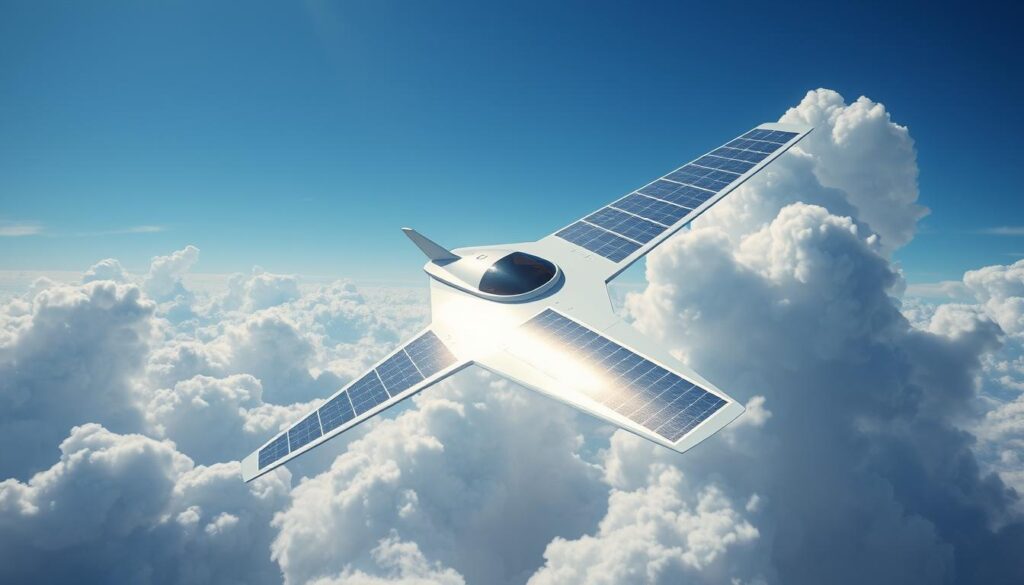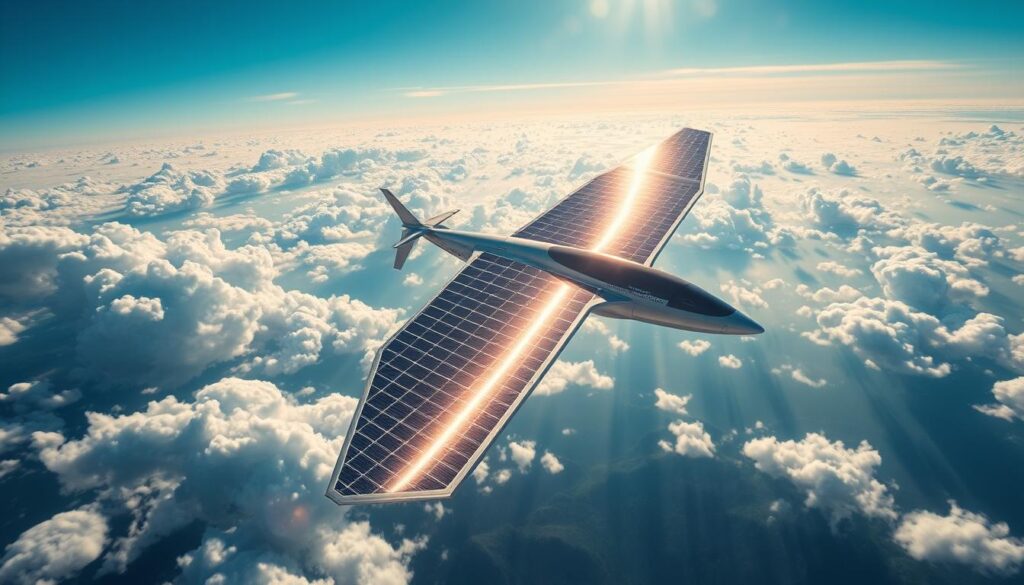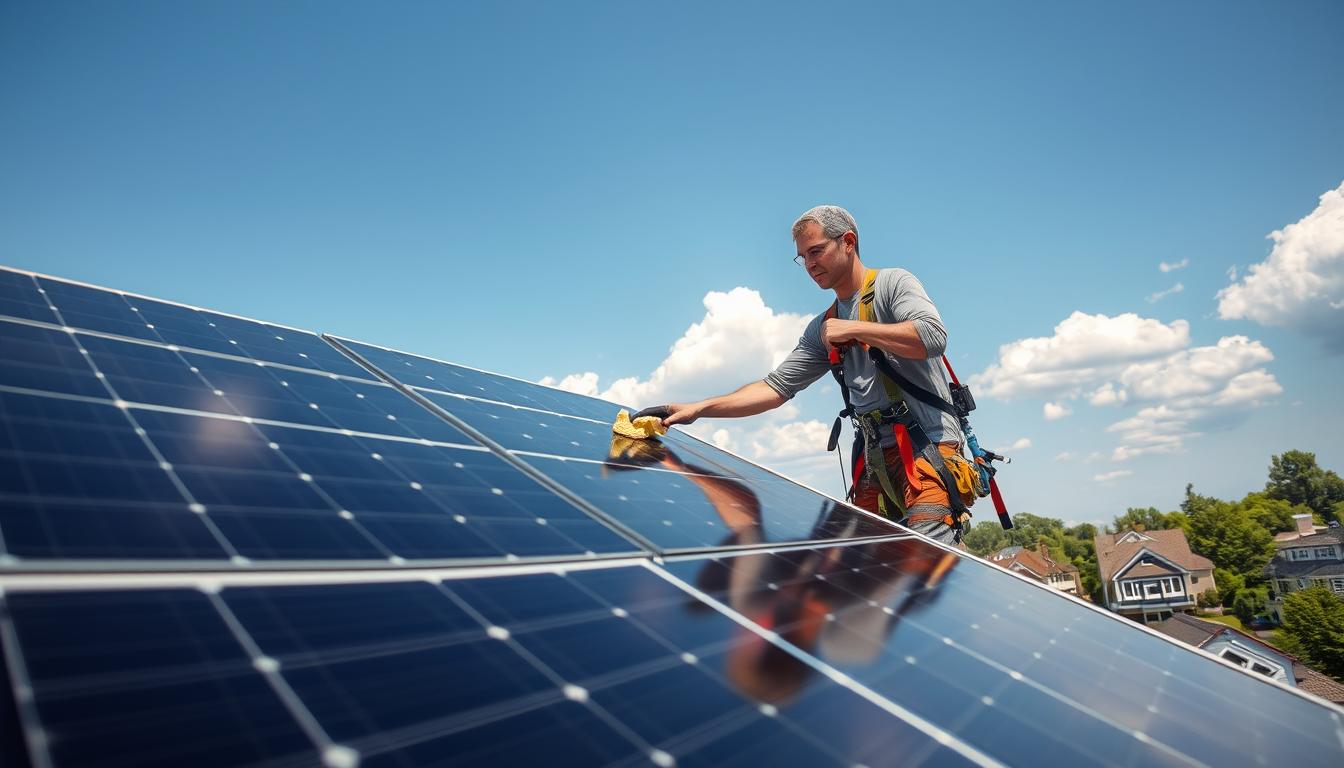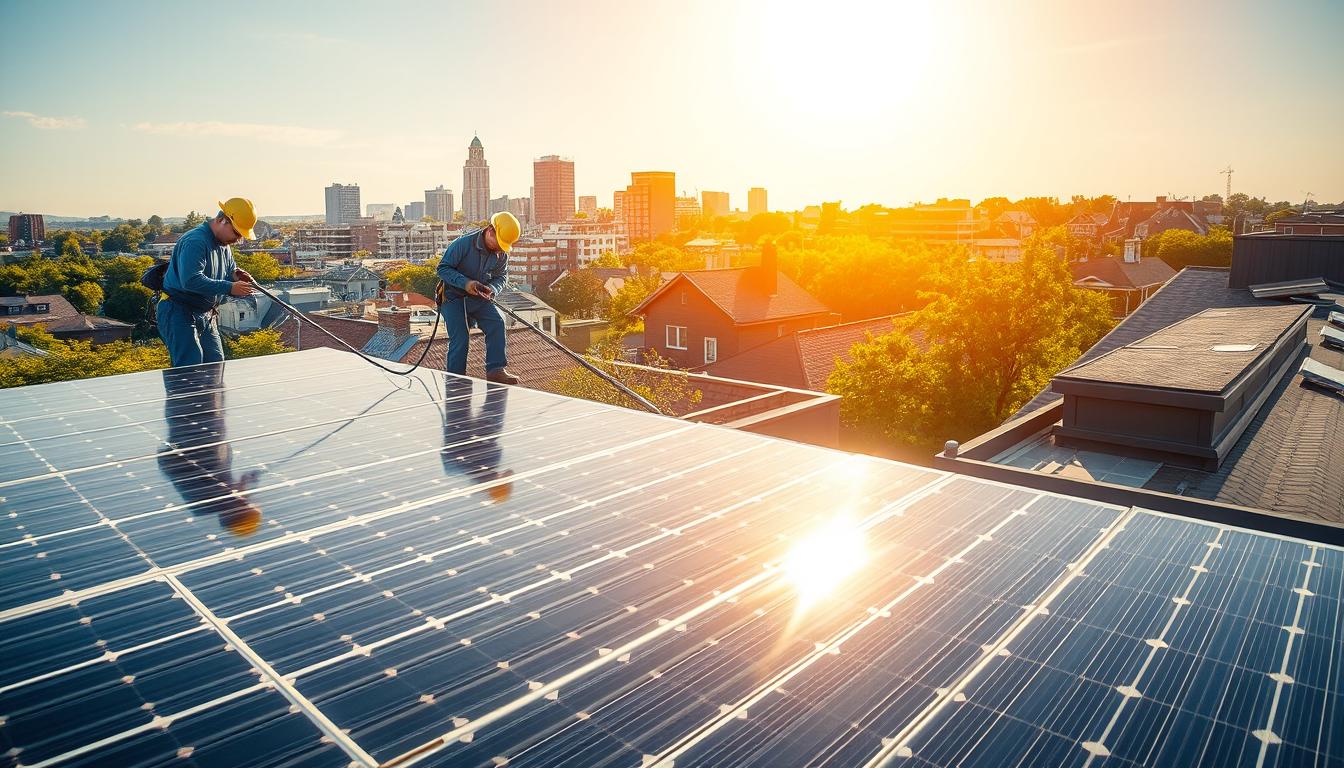Can a solar-powered aircraft fly around the world without stopping for fuel? The story of Solar Impulse 2 shows it’s possible. Led by André Borschberg, this aircraft made history with the longest solo flight without stopping. It flew from Nanjing, China to Kalaeloa, Hawaii in five days.
This flight covered 8,200 kilometers. Solar Impulse 2 is huge, with a wingspan like a Boeing 747, but it’s as light as a car. Its 7,000 solar cells prove that solar flight is a real option for green air travel.
Key Takeaways
- Solar Impulse 2 achieved the longest non-stop solo flight ever recorded.
- It flew from Nanjing, China to Kalaeloa, Hawaii, covering 8,200 kilometers.
- The aircraft is powered by 7,000 solar cells, showcasing its efficiency in renewable energy aviation.
- Solar Impulse 2 has a wingspan larger than a Boeing 747 but weighs about the same as a car.
- This flight finalizes a round-the-world trip, marking a significant milestone in solar flight endurance records.
- Steve Fossett previously held the record before being surpassed by Solar Impulse 2.
- Such advancements highlight the potential of solar-powered aircraft for sustainable air travel.
Introduction to Solar Aviation
Solar aviation has made big strides, changing the world of flight. It uses solar energy in planes, marking big steps in green aviation. This move brings us closer to flying without harming the environment.
The Evolution of Solar-Powered Aircraft
The start of solar-powered planes was with simple designs. Now, they are advanced and can do amazing things. Solar panels on planes turn sunlight into power, making flying greener.
From doubts to today’s achievements, solar aviation is growing. It shows solar planes can be part of regular air travel.
Importance of Solar Flight in Sustainable Air Travel
Solar flight is key for green air travel. Solar planes show flying without pollution is possible and useful. They show the aviation world’s goal to have zero emissions.
Projects like Solar Impulse are leading the way. They prove flying long distances on solar power is doable.
Solar Impulse Project: A Pioneer in Solar Aviation

The Solar Impulse project is a groundbreaking effort in sustainable air travel. Led by Bertrand Piccard and André Borschberg, it showed solar power’s potential in flying. It pushed the limits of eco-friendly flying.
Founders and Vision
In 2004, Bertrand Piccard, inspired by a feasibility study, started the solar aviation dream. He teamed up with pilot André Borschberg. Together, they aimed to change air travel to be more sustainable. They wanted to show solar power’s reliability and efficiency in flight.
Project Goals and Achievements
The Solar Impulse project had clear goals:
- Promote renewable energy and clean technologies.
- Prove long-distance flights with solar power are possible.
- Encourage future innovations in green air travel.
The project’s first success was Solar Impulse 1, which did test flights. Then, Solar Impulse 2 was built in 2014. Its biggest achievement was flying around the world on solar power, covering about 26,000 miles.
This journey highlighted renewable energy’s importance in flying. Here are some key milestones:
| Aircraft | Launch Year | Key Achievements |
|---|---|---|
| Solar Impulse 1 | 2009 | First solar-powered night flight |
| Solar Impulse 2 | 2014 | First solar-powered circumnavigation |
The Solar Impulse project’s success shows solar energy’s potential in flying. It sets a standard for a greener air travel future.
Technical Specifications of Solar Impulse 2
The Solar Impulse 2 is a symbol of modern aviation technology. It shows the highest level of innovation in solar-powered flight. This aircraft is the result of years of hard work and research, with features that make it stand out in sustainable air travel.
Solar Cells and Electric Motors
At the heart of Solar Impulse 2 are 7,000 photovoltaic cells. These cells catch sunlight to power the plane. They drive four electric motors, showing top-notch aviation technology.
This setup lets the plane fly during the day and charge its batteries for night. It ensures the plane keeps flying smoothly.
Wingspan and Weight
The solar Impulse 2 specifications are impressive. It has a huge wingspan of 72 meters. It weighs 2,300 kilograms, like a typical family car.
This size and weight show the plane’s design is both elegant and efficient. The wingspan also helps with stability, key for long flights.
Energy Efficiency and Reliability
Energy efficiency is key in Solar Impulse 2’s design. It can store and use solar energy well, leading to long flights. Its electric motors are reliable, keeping the plane in top shape.
The plane’s tech also makes it very energy-efficient. This makes Solar Impulse 2 a shining example of solar-powered flight’s potential.
The amazing specs of Solar Impulse 2 open up new possibilities in aviation. It shows the way to more sustainable and efficient air travel in the future.
What is the Furthest Recorded Solar Powered Flight

The longest solar-powered flight was made by Solar Impulse 2. It was piloted by Andre Borschberg. This flight went non-stop from Nanjing, China to Hawaii, USA. It covered an amazing 5,095 miles, showing how far solar energy can take us in flying.
The trip lasted five days and nights. It’s one of the biggest achievements in flying history. It shows how far solar flight tech has come. Solar Impulse 2’s success is a big step towards flying that’s better for our planet.
| Flight Aspect | Details |
|---|---|
| Event | Longest Solar-Powered Flight |
| Aircraft | Solar Impulse 2 |
| Pilot | Andre Borschberg |
| Distance | 5,095 miles |
| Duration | 5 days and nights |
| Route | Nanjing, China to Hawaii, USA |
The Journey of Solar Impulse 2: Key Milestones
The journey of Solar Impulse 2 shows the power of innovation and endurance in flying with the sun. This amazing trip, known as the Solar Impulse circumnavigation, faced many challenges. Yet, it reached key milestones that showed flying green is possible.
Commencement and Initial Legs
In March 2015, Solar Impulse 2 took off from Abu Dhabi, the capital of the United Arab Emirates. This was the start of a long and ambitious trip around the world using only solar power. The first parts of the trip took the plane across Asia, stopping in places like Muscat in Oman and Varanasi in India.
Each stop was important for testing the plane and preparing for the rest of the journey.
Critical Challenges and Solutions
The trip wasn’t easy. One big problem was the plane’s batteries overheating over the Pacific Ocean. This could have stopped the mission. But the team quickly came up with a solution.
They made a new cooling system for the batteries. This kept the plane running well, even when it was hot. This shows how smart and determined people can solve big problems.
Final Leg and Record-Breaking Achievement
The last part of the trip was very important. The plane flew from Japan to Hawaii, setting a new record for the longest solar flight. This flight was over 5,500 miles long, lasting five days and five nights.
This amazing feat showed how strong the plane and the team were. It also proved that flying with clean energy is possible.
| Milestone | Detail |
|---|---|
| Start of Journey | Abu Dhabi, March 2015 |
| Initial Legs | Asia – Oman, India, Myanmar, China |
| Critical Challenges | Battery overheating; Innovative cooling solutions |
| Final Leg | Japan to Hawaii – Record-breaking achievement |
Comparison with Previous Solar Flight Records
Before Solar Impulse 2’s journey, there were already notable solar flight records. One of the most impressive was Steve Fossett’s record for the longest non-stop solo flight. He achieved this in 2006, lasting about 76 hours.
Steve Fossett’s Record
Steve Fossett’s achievement showed human endurance and early solar flight technology. His flight set a new benchmark and drew attention to solar-powered aviation. It showed the early steps in using solar energy in flying, leading to future progress.
Technological Advancements Over the Years
After Steve Fossett’s record, solar aviation made big strides. These changes were key for Solar Impulse 2 to beat previous records. The journey from early solar flights to Solar Impulse 2 shows huge tech progress in solar flying.
- Enhanced solar cells that capture more energy and work better.
- Lighter materials that help planes fly better.
- Improved energy storage for longer, more reliable flights.
These advancements let Solar Impulse 2 far outdo earlier records. It marked a big step in solar aviation history.
| Flight Record | Year | Duration | Key Innovations |
|---|---|---|---|
| Steve Fossett’s Solo Flight | 2006 | Approximately 76 hours | Initial integration of solar technology |
| Solar Impulse 2 | 2015-2016 | Extended duration and multiple legs | Advanced solar cells, lightweight materials, improved energy storage |
Engineering Marvel: The Technology Behind Solar Impulse 2
Solar Impulse 2 is a technological wonder. It uses photovoltaic technology, advanced energy storage, and a lightweight design. These innovations allowed it to set new records in solar flight.
Photovoltaic Cells and Energy Storage
The heart of Solar Impulse 2 is its photovoltaic cells. These thin, efficient cells cover the wings, catching sunlight all day. The plane also has special batteries to store extra energy.
This system lets the plane keep flying at night. It shows how solar power can change aviation.
Lightweight Materials and Structural Design
Lightweight design is key for Solar Impulse 2’s success. It uses a carbon fiber structure that’s strong but light. This design helps the plane fly high and for a long time.
It shows how important lightweight materials are in aviation today.
| Feature | Specification |
|---|---|
| Photovoltaic Technology | Ultra-thin solar cells on wings |
| Energy Storage | Lithium polymer batteries |
| Lightweight Design | Carbon fiber honeycomb structure |
Human Factors in Endurance Solar Flights
Endurance solar flights need a mix of physical strength and mental toughness. Pilots face many challenges, from long hours to staying focused. They must be well-trained to handle these issues.
Pilot Training and Preparation
Pilots go through tough training before flying for a long time. People like Andre Borschberg show how much prep is needed. They learn to fly in extreme conditions and use solar power.
They also learn to fly safely at high altitudes. This requires both physical and technical skills. It’s all about staying safe and successful.
Psychological and Physical Challenges
Psychological challenges are big in aviation, especially on long solar flights. Pilots need to stay mentally strong. They face long periods alone, which is tough.
The physical side is also hard. They have to keep their health up, sleep little, and stay alert. It’s a big challenge to balance these demands.
FAQ
What is the furthest recorded solar-powered flight?
How many hours did Solar Impulse 2 fly non-stop to set the record?
What are the key technical specifications of Solar Impulse 2?
Who were the founders of the Solar Impulse project?
Why is solar aviation important for sustainable air travel?
What were some critical challenges faced during Solar Impulse 2’s journey?
How did Solar Impulse 2 compare to Steve Fossett’s record?
What significant achievements did the Solar Impulse project accomplish?
What innovative technologies were used in Solar Impulse 2?
What considerations were necessary for pilot preparation in endurance solar flights?
Source Links
- Solar Impulse – https://en.wikipedia.org/wiki/Solar_Impulse
- Solar Impulse – Around the world to promote clean technologies – https://aroundtheworld.solarimpulse.com/adventure
- Solar plane breaks record for longest flight – https://www.cnbc.com/2015/07/03/solar-impulse-2-breaks-world-record-for-longest-non-stop-flight.html




Interesting read, but arent we ignoring the fact that solar-powered flights arent viable for long haul trips or night flights? Just a thought.
Interesting read, but arent we ignoring the fact that solar flights are heavily weather-dependent? Rainy days, anyone? Whats Plan B? 🤔✈️☔
Interesting read, but arent we ignoring the production cost & environmental impact of the solar cells themselves? Maybe theyre not that green after all.